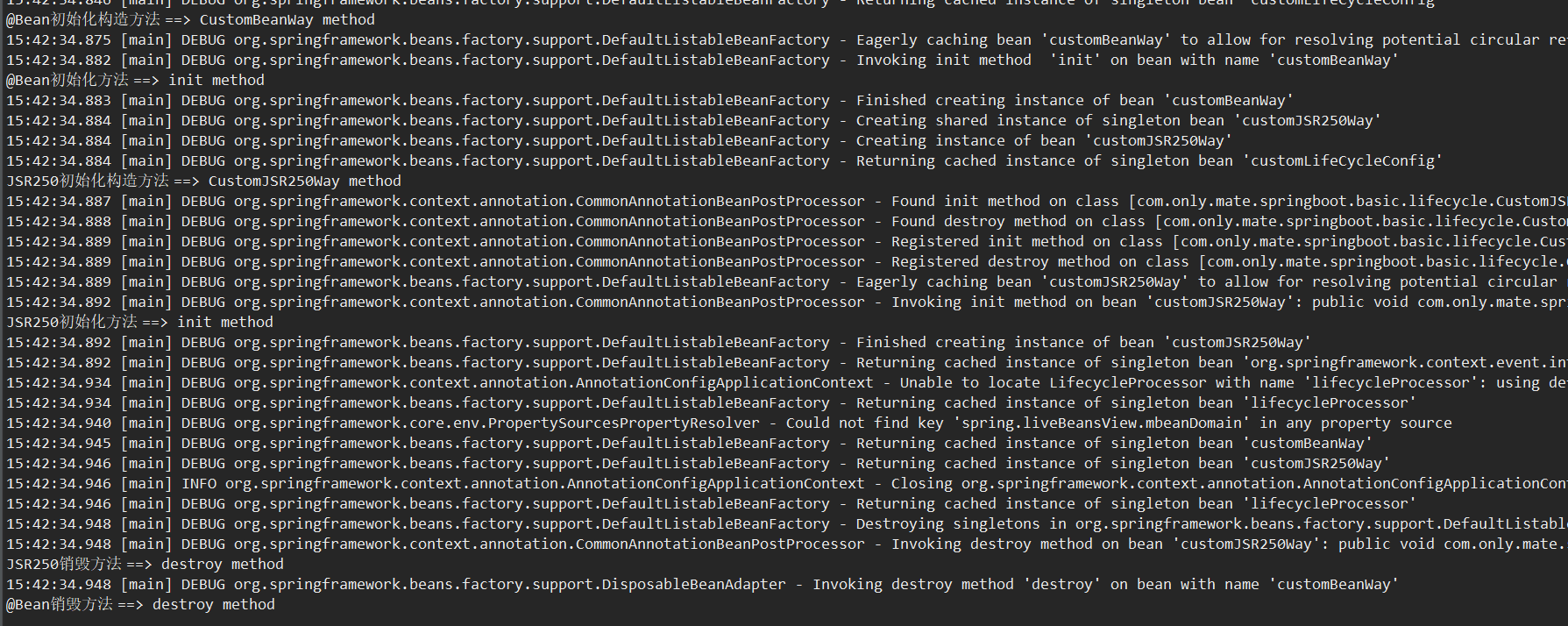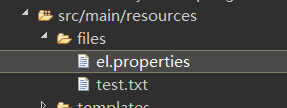Spring Boot实践——基础和常用配置
借鉴:https://blog.csdn.net/j903829182/article/details/74906948
一、Spring Boot 启动注解说明
@SpringBootApplication开启了Spring的组件扫描和Spring Boot的自动配置功能。实际上, @SpringBootApplication将三个有用的注解组合在了一起。
- Spring的@Configuration:标明该类使用Spring基于Java的配置。虽然本书不会写太多配置,但我们会更倾向于使用基于Java而不是XML的配置。
- Spring的@ComponentScan:启用组件扫描,这样你写的Web控制器类和其他组件才能被自动发现并注册为Spring应用程序上下文里的Bean。默认扫描
@SpringBootApplication所在类的同级目录以及它的子目录。本章稍后会写一个简单的Spring MVC控制器,使用@Controller进行注解,这样组件扫描才能找到它。 - Spring Boot 的 @EnableAutoConfiguration: 这 个 不 起 眼 的 小 注 解 也 可 以 称 为@Abracadabra①,就是这一行配置开启了Spring Boot自动配置的魔力,让你不用再写成篇的配置了。
在Spring Boot的早期版本中,你需要在ReadingListApplication类上同时标上这三个注解,但从Spring Boot 1.2.0开始,有@SpringBootApplication就行了。
二、Bean的scope
scope描述了spring容器如何新建bena的实例,spring的scope有以下几种,通过@Scope注解来实现
- Singleton:一个spring容器中只有一个bena的实例,此为spring的默认配置,全容器共享一个实例的bean。
- Prototype:每次调用新建一个bean的实例。
- Request:web项目中,给每一个http request新建一个Bean实例。
- Session :web项目中,给每一个http session新建一个实例。
- GlobalSession:这个只在portal应用中有用,给每一个global http session新建一个bean实例。
另外,在spring batch中还有一个Scope是使用@StepScope,用在批处理中。
实例:
定义一个Single的Bean
/** * @Description: 自定义Single实例 * @ClassName: CustomSingleService * @author OnlyMate * @Date 2018年9月13日 上午10:34:36 * */ @Service //默认为Sinleton,相当于@Scope("singleton") @Scope(value="singleton") public class CustomSingleService { }
定义一个Prototype的Bean
/** * @Description: 自定义Prototype实例 * @ClassName: CustomPrototypeService * @author OnlyMate * @Date 2018年9月13日 上午10:34:36 * */ @Service @Scope(value="prototype") public class CustomPrototypeService { }
Bean的Scope配置
import org.springframework.context.annotation.ComponentScan; import org.springframework.context.annotation.Configuration; /** * @Description: 自定义Bean的Scope配置类 * @ClassName: CustomScopConfig * @author OnlyMate * @Date 2018年9月13日 上午10:59:54 * */ @Configuration @ComponentScan(value="com.only.mate.springboot.basic.scope") public class CustomScopConfig { }
测试类
import org.springframework.context.annotation.AnnotationConfigApplicationContext; import com.only.mate.springboot.configure.basic.CustomScopConfig; public class CustomScopeMain { public static void main(String[] args) { // AnnotationConfigApplicationContext作为spring容器,接受一个配置类作为参数 AnnotationConfigApplicationContext context = new AnnotationConfigApplicationContext(CustomScopConfig.class); CustomSingleService cs1 = context.getBean(CustomSingleService.class); CustomPrototypeService cp1 = context.getBean(CustomPrototypeService.class); CustomSingleService cs2 = context.getBean(CustomSingleService.class); CustomPrototypeService cp2 = context.getBean(CustomPrototypeService.class); System.out.println("cs1与cs2是否相等:" + cs1.equals(cs2)); System.out.println("cp1与cp2是否相等:" + cp1.equals(cp2)); context.close(); } }
结果:

三、Bean的初始化和销毁
在我们实际开发的时候,经常会遇到在bean使用之前或者之后做一些必要的操作,spring 对bean的生命周期的操作提供了支持。在使用java配置和注解配置下提供如下两种方式:
- java配置方式:使用@Bean的initMethod和destroyMethod(相当于xml配置的init-method和destory-method)
- 注解方式:利用JSR-250的@PostConstruct和@PreDestroy
1、增加JSR250支持
<!--增加JSR250支持--> <dependency> <groupId>javax.annotation</groupId> <artifactId>jsr250-api</artifactId> <version>1.0</version> </dependency>
2、使用@Bean形式的bean
/** * @Description: 自定义@Bean方式的初始化和销毁方法 * @ClassName: CustomBeanWay * @author OnlyMate * @Date 2018年9月13日 上午11:15:41 * */ public class CustomBeanWay { public CustomBeanWay() { super(); System.out.println("@Bean初始化构造方法 ==> CustomBeanWay method"); } public void init() { System.out.println("@Bean初始化方法 ==> init method"); } public void destroy() { System.out.println("@Bean销毁方法 ==> destroy method"); } }
3、使用JSR250形式的bean
/** * @Description: 自定义JSR250方式的初始化和销毁方法 * @ClassName: CustomJSR250Way * @author OnlyMate * @Date 2018年9月13日 上午11:15:41 * */ public class CustomJSR250Way { public CustomJSR250Way() { super(); System.out.println("JSR250初始化构造方法 ==> CustomJSR250Way method"); } @PostConstruct public void init() { System.out.println("JSR250初始化方法 ==> init method"); } @PreDestroy public void destroy() { System.out.println("JSR250销毁方法 ==> destroy method"); } }
4、配置
import org.springframework.context.annotation.Bean; import org.springframework.context.annotation.ComponentScan; import org.springframework.context.annotation.Configuration; import com.only.mate.springboot.basic.lifecycle.CustomBeanWay; import com.only.mate.springboot.basic.lifecycle.CustomJSR250Way; @Configuration @ComponentScan(value="com.only.mate.springboot.basic.lifecycle") public class CustomLifeCycleConfig { @Bean(initMethod = "init",destroyMethod = "destroy") public CustomBeanWay customBeanWay(){ return new CustomBeanWay(); } @Bean public CustomJSR250Way customJSR250Way(){ return new CustomJSR250Way(); } }
5、启动
import org.springframework.context.annotation.AnnotationConfigApplicationContext; import com.only.mate.springboot.configure.lifecycle.CustomLifeCycleConfig; @SuppressWarnings("unused") public class CustomLifeCycleMain { public static void main(String[] args) { // AnnotationConfigApplicationContext作为spring容器,接受一个配置类作为参数 AnnotationConfigApplicationContext context = new AnnotationConfigApplicationContext(CustomLifeCycleConfig.class); CustomBeanWay customBeanWay = context.getBean(CustomBeanWay.class); CustomJSR250Way customJSR250Way = context.getBean(CustomJSR250Way.class); context.close(); } }
6、效果图

可见init方法和destory方法在构造方法之后,bean销毁之前执行。
四、Spring EL和资源调用
spring EL-Spring表达式语言,支持在xml和注解中使用表达式,类似于jsp的EL表达式语言。
spring开发中经常涉及调用各种资源的情况,包含普通文件,网址,配置文件,系统环境变量等,我们可以使用 spring表达式语言实现资源的注入。
spring主要在注解@Vavle的参数中使用表达式。
下面演示一下几种情况:
- 注入普通字符串
- 注入操作系统属性
- 注入表达式运算结果
- 注入其他Bean的属性
- 注入文件内容
- 注入网址内容
- 注入属性文件
1、准备,增加commons-io可简化文件相关的操作,本例使用commons-io将file转换成字符串。
<!--增加commons-io可简化文件相关操作-->
<dependency>
<groupId>commons-io</groupId>
<artifactId>commons-io</artifactId>
<version>2.3</version>
</dependency>
2、创建文件
在resources下简历files文件夹,并创建el.properties和test.txt文件
内容如下:
el.properties
book.author=onlymate book.name=Java is s magic
test.txt
这是test.txt里面的内容,很高兴认识大家

3、需被注入的bean
@Component public class CustomElBean { //注入普通字符串 @Value("其他类属性") private String another; public String getAnother() { return another; } public void setAnother(String another) { this.another = another; } }
4、配置类
import java.nio.charset.Charset; import org.apache.commons.io.IOUtils; import org.springframework.beans.factory.annotation.Autowired; import org.springframework.beans.factory.annotation.Value; import org.springframework.context.annotation.Bean; import org.springframework.context.annotation.ComponentScan; import org.springframework.context.annotation.Configuration; import org.springframework.context.annotation.PropertySource; import org.springframework.context.support.PropertySourcesPlaceholderConfigurer; import org.springframework.core.env.Environment; import org.springframework.core.io.Resource; /** * @Description: 自定义el配置类 * @ClassName: CustomElConfig * @author OnlyMate * @Date 2018年9月13日 上午10:59:54 * */ @Configuration @ComponentScan(basePackages="com.only.mate.springboot.basic.el") //注入配置文件需要使用@PropertySource指定文件地址,若使用@Value注入,则要配置一个PropertySourcesPlaceholderConfigurer的bean //注意,@ @Value("${book.name}")使用的是$而不是# //注入Properties还可以从Environment中获得 @PropertySource("classpath:files/el.properties") public class CustomElConfig { //注入普通字符串 @Value("I Love YOU!") private String normal; //注入操作系统属性 @Value("#{systemProperties['os.name']}") private String osName; //注入表达式结果 @Value("#{T(java.lang.Math).random()*100.0}") private double randomNumber; //注入其他的bean属性 @Value("#{customElBean.another}") private String fromAnother; //注入文件资源 @Value("classpath:files/test.txt") private Resource testFile; //注入网址资源 @Value("http://www.baidu.com") private Resource testUrl; //注入配置文件 @Value("${book.name}") private String bookNmame; //注入环境 @Autowired private Environment environment; @Bean public static PropertySourcesPlaceholderConfigurer propertyConfigure(){ return new PropertySourcesPlaceholderConfigurer(); } public void outputResource(){ try { System.out.println(normal); System.out.println(osName); System.out.println(randomNumber); System.out.println(fromAnother); System.out.println(IOUtils.toString(testFile.getInputStream(), Charset.defaultCharset())); System.out.println(IOUtils.toString(testUrl.getInputStream(), Charset.defaultCharset())); System.out.println(bookNmame); System.out.println(environment.getProperty("book.author")); }catch (Exception e){ e.printStackTrace(); System.out.println(e); } } }
5、启动运行
import org.springframework.context.annotation.AnnotationConfigApplicationContext; import com.only.mate.springboot.configure.el.CustomElConfig; public class CustomElMain { public static void main(String [] args){ //AnnotationConfigApplicationContext作为spring容器,接受一个配置类作为参数 AnnotationConfigApplicationContext context = new AnnotationConfigApplicationContext(CustomElConfig.class); CustomElConfig elConfig = context.getBean(CustomElConfig.class); elConfig.outputResource(); context.close(); } }
6、效果图

五、Profile
1、基础练习
Profile为在不同环境下使用不同的配置提供了支持(开发环境下的配置和生产环境下的配置不同,比如数据库)
- 通过设定Enviroment的ActiveProfiles来设定当前context需要使用的配置环境。在开发中使用@Profile注解类或者方法,达到在不同情况下选择实例化不同的Bean
- 通过设定jvm的spring.profiles.active参数来设置配置环境
- Web项目设置在Servlet的context parameter中
1、定义一个bean
/** * @Description: 定义一个bean * @ClassName: CustomProfileBean * @author OnlyMate * @Date 2018年9月13日 下午4:26:22 * */ public class CustomProfileBean { private String content; public CustomProfileBean(String content) { super(); this.content = content; } public String getContent() { return content; } public void setContent(String content) { this.content = content; } }
2、配置
/** * @Description: 自定义Profile的配置类 * @ClassName: CustomProfileConfig * @author OnlyMate * @Date 2018年9月13日 下午4:27:17 * */ @Configuration public class CustomProfileConfig { @Bean @Profile("dev")//Profile为dev时实例化devCustomProfileBean public CustomProfileBean devCustomProfileBean(){ return new CustomProfileBean("from development pfofile"); } @Bean @Profile("prod")//Profile为prod时实例化prodCustomProfileBean public CustomProfileBean prodCustomProfileBean(){ return new CustomProfileBean("from production profile"); } }
3、启动运行
/** * @Description: * @ClassName: CustomProfileMain * @author OnlyMate * @Date 2018年9月13日 下午4:26:22 * */ public class CustomProfileMain { public static void main(String [] args){ //AnnotationConfigApplicationContext作为spring容器,接受一个配置类作为参数 AnnotationConfigApplicationContext context = new AnnotationConfigApplicationContext(); //先将活动的Profile设置为prod context.getEnvironment().setActiveProfiles("prod"); //后置注册Bean配置类,不然会报bean未定义的错误 context.register(CustomProfileConfig.class); //刷新容器 context.refresh(); CustomProfileBean demoBean = context.getBean(CustomProfileBean.class); System.out.println(demoBean.getContent()); context.close(); } }
4、效果图

2、日志信息的配置
logback-spring.xml
<?xml version="1.0" encoding="UTF-8"?> <configuration debug="true"><!-- debug="true"设置调试模式 --> <!--定义日志文件的存储地址 勿在 LogBack 的配置中使用相对路径,文件要以logback-spring.xml命名--> <springProfile name="test"> <property name="catalina.base" value="/home/webapp/logs/spring-boot" /> </springProfile> <springProfile name="prod"> <property name="catalina.base" value="/app/webapp/logs/spring-boot" /> </springProfile> <springProfile name="dev"> <property name="catalina.base" value="H:/logs/spring-boot" /> </springProfile> <!--<springProperty scope="context" name="catalina.base" source="catalina.base"/>--> <!-- 日志地址 --> <!--<property name="catalina.base" value="H:/logs"></property>--> <!-- 控制台输出 --> <appender name="STDOUT" class="ch.qos.logback.core.ConsoleAppender"> <encoder class="ch.qos.logback.classic.encoder.PatternLayoutEncoder"> <pattern>%d{yyyy-MM-dd HH:mm:ss.SSS} 耗时:%r 日志来自:%logger{50} 日志类型: %-5p 日志内容:%m%n</pattern> </encoder> </appender> <!-- 按照每天生成日志文件 --> <appender name="DEFAULT-APPENDER" class="ch.qos.logback.core.rolling.RollingFileAppender"> <File>${catalina.base}/logs/common-default.log</File> <rollingPolicy class="ch.qos.logback.core.rolling.TimeBasedRollingPolicy"> <!--日志文件输出的文件名 --> <FileNamePattern>${catalina.base}/logs/common-default-%d{yyyy-MM-dd}.log</FileNamePattern> <!--日志文件保留天数 --> <MaxHistory>30</MaxHistory> </rollingPolicy> <encoder class="ch.qos.logback.classic.encoder.PatternLayoutEncoder"> <!--格式化输出:%d表示日期,%thread表示线程名,%-5level:级别从左显示5个字符宽度%msg:日志消息,%n是换行符 --> <pattern>%d{yyyy-MM-dd HH:mm:ss.SSS} [%thread] %-5level %logger{50} - %msg%n</pattern> </encoder> <!--日志文件最大的大小 --> <triggeringPolicy class="ch.qos.logback.core.rolling.SizeBasedTriggeringPolicy"> <MaxFileSize>10MB</MaxFileSize> </triggeringPolicy> </appender> <!-- 按照每天生成日志文件 --> <appender name="INFO-APPENDER" class="ch.qos.logback.core.rolling.RollingFileAppender"> <File>${catalina.base}/logs/info-log.log</File> <rollingPolicy class="ch.qos.logback.core.rolling.TimeBasedRollingPolicy"> <!--日志文件输出的文件名 --> <FileNamePattern>${catalina.base}/logs/info-log-%d{yyyy-MM-dd}.log</FileNamePattern> <!--日志文件保留天数 --> <MaxHistory>30</MaxHistory> </rollingPolicy> <encoder class="ch.qos.logback.classic.encoder.PatternLayoutEncoder"> <!-- 格式化输出:%d表示日期,%thread表示线程名,%-5level:级别从左显示5个字符宽度%msg:日志消息,%n是换行符 --> <pattern>%d{yyyy-MM-dd HH:mm:ss.SSS} [%thread] %-5level %logger{50} - %msg%n</pattern> </encoder> <!--日志文件最大的大小 --> <triggeringPolicy class="ch.qos.logback.core.rolling.SizeBasedTriggeringPolicy"> <MaxFileSize>10MB</MaxFileSize> </triggeringPolicy> </appender> <logger name="com.google.code.yanf4j" level="ERROR" /> <!-- show parameters for hibernate sql 专为 Hibernate 定制 --> <logger name="org.hibernate.type.descriptor.sql.BasicBinder" level="TRACE" /> <logger name="org.hibernate.type.descriptor.sql.BasicExtractor" level="DEBUG" /> <logger name="org.hibernate.SQL" level="DEBUG" /> <logger name="org.hibernate.engine.QueryParameters" level="DEBUG" /> <logger name="org.hibernate.engine.query.HQLQueryPlan" level="DEBUG" /> <!--myibatis log configure--> <logger name="org.apache.ibatis" level="DEBUG"/> <logger name="java.sql.Connection" level="DEBUG"/> <logger name="java.sql.Statement" level="DEBUG"/> <logger name="java.sql.PreparedStatement" level="DEBUG"/> <logger name="net.rubyeye.xmemcached" level="INFO"/> <logger name="org.springframework" level="INFO"/> <logger name="net.sf.ehcache" level="INFO"/> <logger name="org.apache.zookeeper" level="INFO" /> <!-- 指定某一个包或者某一个类的打印级别以及是否传入root进行打印 --> <!-- addtivity:是否向上级loger传递打印信息。默认是true。--> <!-- <loger>可以包含零个或多个<appender-ref>元素,标识这个appender将会添加到这个loger。--> <!-- name:用来指定受此loger约束的某一个包或者具体的某一个类。--> <!-- level: 用来设置打印级别,大小写无关:TRACE, DEBUG, INFO, WARN, ERROR, ALL 和 OFF,还有一个特俗值INHERITED或者同义词NULL,代表强制执行上级的级别。 如果未设置此属性,那么当前loger将会继承上级的级别。--> <!-- 为所有开头为dao的类打印sql语句 --> <!-- <logger name="dao" level="DEBUG"> <appender-ref ref="INFO-APPENDER" /> </logger> --> <logger name="com.only.mate" level="DEBUG" additivity="true"> <appender-ref ref="INFO-APPENDER" /> </logger> <!-- 也是<loger>元素,但是它是根loger。只有一个level属性,应为已经被命名为"root". --> <root level="DEBUG"> <appender-ref ref="STDOUT"/> <appender-ref ref="DEFAULT-APPENDER"/> </root> </configuration>
这里有兴趣的自己自己尝试。
3、Java代码中根据系统环境处理逻辑
创建一个服务,实现ApplicationContextAware接口
import org.springframework.beans.BeansException; import org.springframework.context.ApplicationContext; import org.springframework.context.ApplicationContextAware; import org.springframework.stereotype.Service; @Service public class CustomProfileService implements ApplicationContextAware{ private ApplicationContext applicationContext = null; @Override public void setApplicationContext(ApplicationContext applicationContext) throws BeansException { this.applicationContext = applicationContext; } public void doSomething() { //获取当前系统环境 String[] springActives = applicationContext.getEnvironment().getActiveProfiles(); String springActive = ""; if(springActives.length > 0) { springActive = springActives[0]; }else { springActive = applicationContext.getEnvironment().getDefaultProfiles()[0]; } System.out.println("当前的开发环境:"+ springActive); } }
配置类
/** * @Description: 自定义Profile的配置类 * @ClassName: CustomProfileConfig * @author OnlyMate * @Date 2018年9月13日 下午4:27:17 * */ @Configuration @ComponentScan(basePackages="com.only.mate.springboot.basic.profile") public class CustomProfileConfig { @Bean @Profile("dev")//Profile为dev时实例化devCustomProfileBean public CustomProfileBean devCustomProfileBean(){ return new CustomProfileBean("from development pfofile"); } @Bean @Profile("prod")//Profile为prod时实例化prodCustomProfileBean public CustomProfileBean prodCustomProfileBean(){ return new CustomProfileBean("from production profile"); } }
启动类
/** * @Description: * @ClassName: CustomProfileMain * @author OnlyMate * @Date 2018年9月13日 下午4:26:22 * */ public class CustomProfileMain { public static void main(String [] args){ //AnnotationConfigApplicationContext作为spring容器,接受一个配置类作为参数 AnnotationConfigApplicationContext context = new AnnotationConfigApplicationContext(); //先将活动的Profile设置为prod context.getEnvironment().setActiveProfiles("prod"); //后置注册Bean配置类,不然会报bean未定义的错误 context.register(CustomProfileConfig.class); //刷新容器 context.refresh(); CustomProfileBean customProfileBean = context.getBean(CustomProfileBean.class); System.out.println(customProfileBean.getContent()); CustomProfileService customProfileService = context.getBean(CustomProfileService.class); customProfileService.doSomething(); context.close(); } }
效果图




 浙公网安备 33010602011771号
浙公网安备 33010602011771号